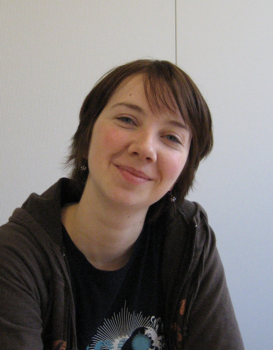Macromolecule substrate interactions in directed self-assembly
Promotion date: 5 April 2007
| I worked with block copolymers comprising two blocks chemically bound together. A typical characteristic of polymers is that they do not mix and tend to phase-separate, like oil en water. I made use of that tendency, optimizing the phase separation and thus creating certain patterns in de polymer structure. I influenced the pattern by increasing or decreasing the length of the polymer molecule. Depending on the material and the length of the blocks you can create a pattern of either cylinders, layers or spheres. |
Why did you do all this?
Let me start by mentioning the variety of applications that are made in the clean room with optical lithography technology. These are surfaces for data storage etcetera. That technology has one major intrinsic limitation: the wavelength of light. Optical lithography is a top down method for nanofabrication, and my research fits into the category of the alternative technology of self assembly of molecules, e.g. the bottom up approach - working from a very small scale upwards to bigger structures. Block copolymers play an important role in the bottom up approach. This is because of the size of the block copolymer features of 10 up to 100 nanometers. In addition, the patterns form by themselves: you do not have to do anything special. And polymers are in general very easy to process besides.
So the bottom up approach has the future?
Well, there are also some problems that need solving. If you look at my structure of spheres on a surface you can easily imagine that this structure would suit high density data storage –we are talking terabytes per square centimetre- very well: you only need to magnetize the spheres. But how to magnetize a sphere of this size? Another problem is to locate the exact spot of a sphere and finally the pattern is only regular over a limited surface of typically about 300 nanometers and then it changes. In the bottom up approach the ‘long range order’ is crucial.
I managed to create a regular pattern over several micrometers using a specific block copolymer. Another part of my thesis dealt with the possibility of influencing this pattern by using substrates with topographic features, i.e. grooves of various shapes.
It turned out that hexagonal grooves in such a pre-fabricated substrate are the most successful, they present a distinct starting point and a ‘long range order’ on micrometer scale.
This is a very good result. In addition, a part of my thesis deals on the interactions between the block copolymers and the substrate. I found out that the interaction between the polymer and the substrate is not nearly so crucial as was believed thus far, which is a very interesting result.
Did you get any publications?
Yes, one was accepted in ‘Chemistry of materials’ and another was published in ‘Journal of nanoscience and nanotechnology’, and another is accepted for publication in ‘Small’.
What did you like best about your research?
I had the opportunity to do measurements in the US. I have been twice to Cornell University to do measurements on a polymer, working day and night with Synchrotron, a particle accelerator. That was fascinating.
What didn’t you like?
In the first year I had good results, I even got a publication accepted. But it took a year before it was actually published. I found that disappointing and also the following two years I got results that I didn’t really understand. I was not really part of a group, so I was pretty much on my own. It felt like groping in the dark and I also sometimes had the feeling that nobody was really interested in what I was doing. That was difficult. But luckily in my final year it more or less fell together.
What are your plans?
I am going to America. I had the option: Canada or the US and I chose the US.
I will do a postdoc there, also involving fundamental research on block copolymers, but in solutions this time. Very interesting – I am really looking forward to it.
For the summary of the thesis, click here (PDF)
Voor de samenvatting van het proefschrift, click hier (PDF)

